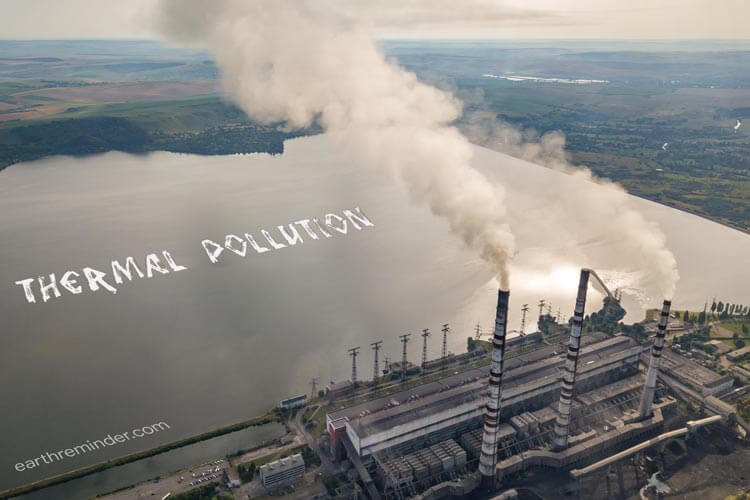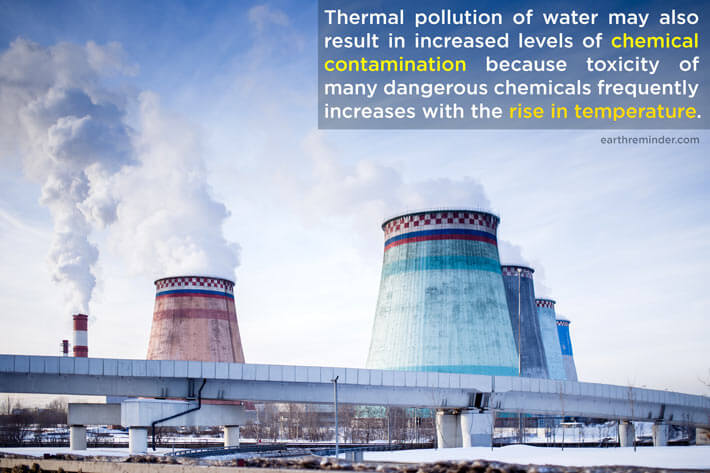Thermal Pollution – Causes, Effects and Control Measures
As of now, we all have understood that environmental pollution like air, water, land, etc. is a significant threat to the organisms living on the planet. Well, talking about thermal pollution, it is also a part of environmental pollution. However, thermal pollution hardly comes to mind when we think about environmental pollution, but it is indeed a big issue for aquatic culture. Therefore, we should concern about the causes, effects, and control measures of thermal pollution.
In simple terms, thermal pollution is when industries or factories take water from natural resources to perform various tasks and release back the high-temperature water in natural resources. This process involves multiple harmful effects on the local ecosystem and communities.
Thermal pollution is best known as sudden increases or decreases in the temperature of water bodies like oceans, seas, rivers, lakes, streams, etc. Usually, the industries use water for cooling purposes for machinery or other production processes.
The governments and each of us need to understand his responsibility to control thermal pollution to save our natural resources. Every human being should also focus on sharing information about this serious environmental issue. This article will help you to understand the significant causes & effects of thermal pollution and what are the preventive measures to treat this ecological problem.
Table of Contents
Causes of Thermal Pollution
What causes thermal pollution? Close your eyes and think for a while, what are the sources of thermal pollution? You will get only one answer that the primary causes are human-made. Well, to tackle this problem, first of all, you need to know its roots.
Water is the cooling agent
Water is the principal cooling agent for various industrial plants, manufacturing & production industries, etc. These industries use a large amount of water from nearby sources to keep their machines fresh and, in return, releases back extreme heat into the water streams.
The underwater organisms have to face the adverse effects of the heat discharge into water bodies. It alters the oxygen level of the water, disturbing aquatic life immensely. Some examples of industries or plants that contribute to thermal pollution include-
Coal-fired power plants
Some thermal power plants use coal as a fuel. For example – coal-fired power plants are one of the primary sources responsible for causing thermal pollution.
Industrial discharge
Industries are contributing a lot to industrial pollution. The industries that deal with electricity generation need a considerable amount of cooling water to release heat. On the other hand, some other industries like paper, sugar, textile and pulp industries, etc. also emit much amount of heat in water but to a minimal extent.
All these industries end up causing thermal pollution affecting the life of the aquatic organisms.
Nuclear Power Plants
Emission from nuclear power plants is quite harmful to the organisms and for the whole environment. The effects of nuclear emissions are extremely hazardous that may affect the environment for many years.
Nuclear power plants release a massive amount of unutilized heat & harmful radioactive waste into nearby water bodies, causing an increase in water temperature.
Emissions from nuclear reactors & processing installations are also contributing to thermal pollution by increasing the temperature of water bodies.
Hydro-electric power
Thermal pollution causes when the contaminants mix with water and increase the temperature of the water. Well, hydro-electric power generation is another reason that enhances the water temperature affecting aquatic life.
Domestic sewage
Domestic sewage is one of the significant environmental problems. It is not only a big reason to cause thermal pollution but leads to many other environmental issues like air pollution, land pollution, water pollution, etc.
Domestic sewage is mostly discharged into the water bodies like rivers, lakes, streams, etc. without proper sewage treatment.
The municipal water sewage that often dumped into water bodies has a higher temperature than the receiving water. When this high-temperature municipal waste gets dissolved with water, it minimizes the level of dissolved oxygen in the water. As a result, the anaerobic conditions occur due to the demand of oxygen increase.
Soil Erosion
Soil erosion is also affecting thermal pollution. The soil erosion is ultimately raising the water bodies increasing the risk factor to get more exposure to sunlight. This is also a big reason for thermal pollution. The aquatic organisms are finding it quite challenging to survive with the alterations in water temperature.
Deforestation
Deforestation is harmful to the environment in all the aspects whether we talk about climate change, global warming, greenhouse effect, or thermal pollution. Trees are known as the green gold of the earth that helps to maintain proper balance in the environment.
Trees & plants protect direct exposure of sunlight on lakes, ponds, rivers, etc. When these water bodies are exposed to sunlight, they start absorbing more heat resulting in thermal pollution. Deforestation also contributes to greenhouse effects causing global warming, which is again helping to thermal pollution.
Some natural causes
Some natural causes like geothermal activity & active volcanoes below oceans & seas also trigger the natural underground heating of the water bodies. Hot & active lava has tremendous heat that can also increase the water temperature.
Eventually, the natural sources of thermal pollution also make marine creatures’ lives very tough to survive in adverse conditions.
Effects of Thermal Pollution
Thermal pollution is a significant threat to plants and animals living underwater. Their life is in danger due to the continuous increase in temperature. Here are some major effects of thermal pollution.
Minimizes the dissolved oxygen level
When the temperature of the water bodies increases, the level of dissolved oxygen decreases. In simple terms, the warm water contains less oxygen as compared to cold water.
The reduction in oxygen level pushes the anaerobic conditions underwater, affecting the life of various plant & animal species. Moreover, warm temperature allows algae to grow on the water surface. The algal growth also minimizes the oxygen level in water bodies.
Alters the water properties
Thermal pollution changes the properties of water.
The mixture of hazardous chemicals from various sources decreases the density and viscosity of water. It also increases the solubility of multiple gases in the water. As a result, the food supply of water creatures gets disrupted.
Increases the toxicity in water
The continuous flow of high-temperature discharges from various industries regulates a considerable amount of toxins in the water bodies. These toxins often contain harmful chemicals & radiation. When aquatic animals come in contact with these toxins, they become susceptible to various diseases.
Loss of biodiversity
This is one of the most severe effects of thermal pollution. Thermal pollution dramatically affects the biological activities underwater that may lead to significant biodiversity loss.
Most of the time, various animal species shift their habitat from one place to another due to warmer temperatures. The organisms that can adapt quickly with the new environmental conditions can survive. On the other hand, those who fail to adjust often become endangered and eventually extinct.
Impacts on biological activities
A sudden temperature increase may cause mass killing of various organisms like fishes, amphibians, insects, etc. Warm water brings favorable conditions for some species, but it may be a big problem for some other species. The sudden loss of biodiversity leads to further issues with the aquatic ecosystem.
A minimal increase in water temperature causes significant changes in the aquatic culture. Whereas, the enormous changes in water temperature may affect the cellular biology of the organisms.
Coral reef bleaching is an ideal example of thermal pollution. When power plants dump their harmful wastes in water bodies, it increases the temperature of the water. As a result, the coral organisms die, known as coral bleaching.
Impacts on reproductive systems
Thermal pollution is showing adverse effects on the reproductive system of aquatic animals. The reproduction of marine animals happens in a specific range of temperatures. Any kind of alterations (especially, increase in water temperature) can affect the reproductive system of those animals.
High temperature can be a reason for the releases of immature eggs. Sometimes, excessive heat can interrupt the healthy development of certain eggs.
Impacts on metabolic rate
Thermal pollution causes an increase in the enzyme activity in the water animals. As a result, animals’ metabolic rate increases due to which the animals need to consume more food than their regular consumption.
Warm water may be suitable for cold-blooded fish and amphibians that only for a limited period. Ultimately, this warmer temperature may hamper the food chain’s stability, creating an imbalance in species composition.
Control Measures for Thermal Pollution
The aquatic ecosystem is an integral part of the environment. Many plant and animal species survive in the aquatic ecosystem. Hence, industries must dump their heat-releasing disposal with proper treatment into water bodies. These are some useful control measures or solutions for thermal pollution which can save aquatic life-
- Installation of human-made structures like cooling ponds and cooling towers will help the areas where a tremendous amount of heat is released through various processes like evaporation convection, radiation, heat transfer, etc.
- The cogeneration process can also be useful in controlling thermal pollution. This process deals with the recycling of heated water for domestic purposes and industrial heating.
- We can implement the concept of the artificial lake as a solution to thermal pollution. These are human-made water bodies where heated substances can be discharged from one end, and water for cooling purposes can be used from the other end.
- Stormwater runoff is managed in underground basins through the infiltration process. This treatment has been included in the planning of the city and also a part of green infrastructure.
- Electricity production is also involved in thermal pollution. Hence, we can help controlling thermal pollution by saving electricity. If consumption is less, then the output will also be minimal.
- Stormwater basins are another treatment for thermal pollution. However, it is not that effective as it does not allow the water to cool. In this process, the water is exposed to the sun.
- The heated water can be released in less vulnerable areas controlling thermal pollution.
- Afforestation is an economical method to treat thermal pollution. Tree plantation along the shoreline will prevent soil erosion, raising the chances of stability in the ecosystem.
Final words
Earth is a unique planet that provides various resources needed for our survival. It is the only planet that sustains life. Hence, we need to understand our responsibility and should take the essential control measures for thermal pollution to save life on earth.

